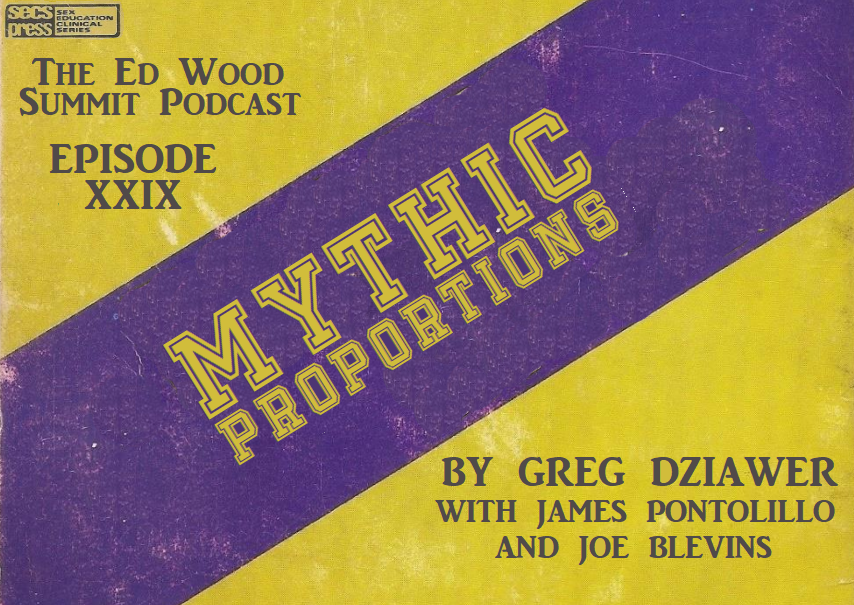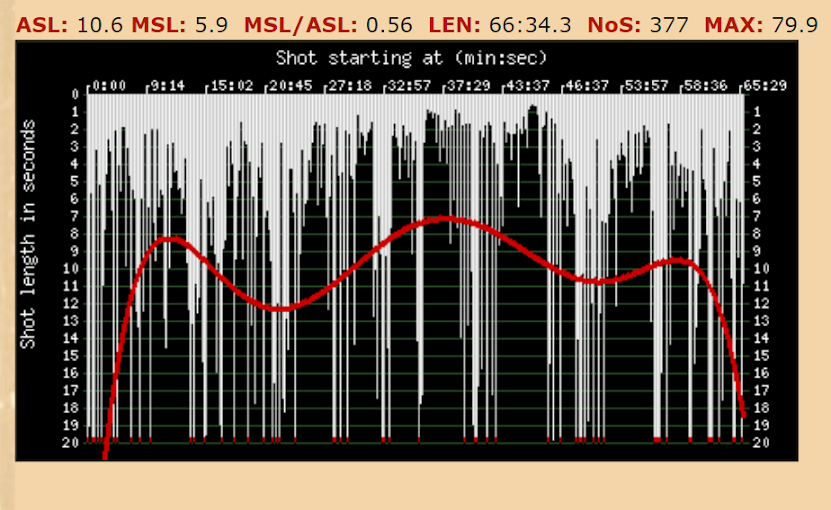 |
| Danny Peary returns to the subject of Ed Wood in Cult Movies 3 (1988). |
Over the course of his three highly influential Cult Movies books, originally published between 1981 and 1988, critic Danny Peary covers a wide variety of offbeat films with devoted fan followings. This makes sense, since "cult" is more of a mindset than a narrowly-defined category. Fittingly, the films Peary discusses hail from different eras, ranging from the 1910s to the 1980s, and represent a number of cinematic genres: comedy, drama, science fiction, horror, action, Western, musical, fantasy, and even pornography. Along the way, Peary also covers a wide variety of filmmakers, everyone from John Ford to John Waters.
 |
| An interesting photo collage poster. |
Still in all, there are a scant few cult directors whose films merit multiple essays in Peary’s Cult Movies books, including Alfred Hitchcock, David Lynch, Martin Scorsese, Michael Curtiz, John Carpenter, George Romero, Stanley Kubrick (to my knowledge, the only director to inspire three essays), Russ Meyer, and our very own Edward D. Wood, Jr. That's right! Eddie's a two-time Cult Movies inductee. That ties him with his idol, Orson Welles.
Seven years after
reviewing Plan 9 from Outer Space (1957) in the original
Cult Movies, Danny Peary reviewed
Glen or Glenda (1953) in
Cult Movies 3 (1988). I'm not sure how I learned of this third volume in the
Cult Movies series, but when I did, I special ordered it immediately from the same Flint bookstore where I'd previously purchased the other two
Cult Movies books. As I remember, it arrived at the same time as the elaborate, oversized script book for
Monty Python's Life of Brian (1979). Getting those two books simultaneously must've been one of the most exciting days of my adolescence.
Keep in mind that I read Danny Peary's books before I ever saw one of Ed Wood's movies, so Peary's essays about Plan 9 and Glenda helped shape my perception of those films. I'm sure Peary has deeply affected the way I write about Ed Wood, even today. So does Cult Movies 3 still have anything to teach me in 2023? Let's find out.
Like all the films included in the Cult Movies series, Glen or Glenda merits a few pages of coverage. We get a cast and crew list, some publicity photos (all B&W), a plot synopsis, and an explanatory essay. The cast and crew list comes directly from Glenda's own credits. No complaints there. The seven-paragraph plot synopsis is surprisingly accurate and lucid, considering the disjointed and often surreal nature of Glen or Glenda. Good job, Danny! Bonus points for working in a reference to "Morpheus, god of sleep."
As for pictures, we get a "slightly out-of-focus shot" (the book's term) of Bela Lugosi mixing chemicals in the lab set. ("It's always enjoyable to see Bela Lugosi," says the caption, "but it's impossible to figure out what his role is in this film.") Peary also gives us a photo-collage poster for the film, supposedly from its original release in 1953. (Tagline: "
Strange Case: ONE BODY--TWO SEXES.") Remarkably,
Cult Movies 3 includes a publicity still from
Glenda's extended nightmare sequence. I was so taken by this picture—showing a woman bound-and-gagged on a couch and being menaced by a second woman—that I included it
in the very first article in this series back in 2013.
 |
| This Bear is no golden turkey, says Peary. |
Peary's essay starts with a broader discussion of the "bad movie" phenomenon, of which Ed Wood is only one part. Harry and Michael Medved's book The Golden Turkey Awards (1980) was fresher in people's memories back then, and it was still the driving force behind the Wood cult in those pre-Tim Burton days. Peary seems to have soured on the Medveds somewhat in the years since reviewing Plan 9, saying that he finds "worst film festivals" to be "particularly annoying" and "the equivalent of self-pleasing sports fans who do 'the Wave.'" (Peary has also written several books about baseball, so his irritation is earned.)
Overall, Peary concludes that Plan 9 and Glenda aren't really among the worst films ever made, "just the worst watchable movies." In this respect, he puts Ed Wood's movies into the same category as Phil Tucker's Robot Monster (1953) and Arch Hall, Sr.'s Eegah! (1962), among others. But Peary has some strict criteria for what constitutes a true "golden turkey." Films like Attack of the Killer Tomatoes! (1978) don't count, he says, because they're self-aware and trying to be campy. ("The hilarity must be unintentional," Peary insists.) Meanwhile, films like I Spit on Your Grave (1978) and Bloodsucking Freaks (1976) are too offensive to be enjoyable. He also rules out movies that are too boring to be fun and cites Michael Chapman's The Clan of the Cave Bear (1986) as his prime example.
Frankly, all this "so bad it's good" stuff doesn't really interest me anymore—even though it's what initially got me into Ed Wood's movies when I was a teenager—so I was relieved when Peary started discussing the specifics of Glen or Glenda. Peary takes a measured approach here, admiring Wood's film for its sincerity and daring while pointing out the film's numerous technical and aesthetic shortcomings. On the one hand, it took genuine courage for Ed Wood to make a movie about cross-dressing and transgenderism in 1953. If you've been following the news at all lately, you know that these issues are still controversial seven decades later in 2023! Eddie not only wrote and directed Glenda, he played the title role himself! Peary gives Wood all due credit for this, even complimenting him for tackling a sensitive "taboo" subject in "a non-exploitive, non-sensationalistic way."
On the other hand, even Glenda's most fervent admirers must admit that this film is cheaply made, haphazardly assembled, and patently ridiculous in many ways, from its stiff acting and its stilted dialogue to its stream-of-consciousness editing style. Peary discusses all of these topics and more in his review of Glen or Glenda. He writes:
Like other Wood films, Glen or Glenda? is distinguished by embarrassingly bad acting, dialogue, direction, cinematography, editing, music, cheap sets, and, significantly, ugly costuming. As usual there are zany moments that are guaranteed to make you both laugh and cringe. [...] The scenes with Lugosi contribute to the film's structural problems and incoherence. Even without his mindless banter, there is enough confusion caused by flashbacks within flashbacks, the use of several narrators, stylistic changes throughout, nonsensical dialogue, and the inclusion of meaningless images (lightning, stampeding buffalo, cars on the highway) only because Wood had free use of these stock shots.
I must say that, when I finally saw Glen or Glenda a few years after reading Cult Movies 3, the film actually exceeded my expectations. Peary's review, descriptive as it is, could not have prepared me for the real movie.
Don't get the impression that this review is all mockery, though. Along the way, Peary makes some cogent points about Glen or Glenda and its approach to transgender issues. I think my favorite observation is: "This is a rare film where men sit at a table (like old-style soap opera women) and converse about their personal problems!" I also appreciated a passage that compares Ed Wood's film to the educational "civics films" that we used to show to middle school and high school students. Peary deftly points out that the "Alan/Ann" sequence near the end of the film, in which a man becomes a woman through surgery and hormone injections, is similar to the process of an immigrant becoming an American citizen.
By the way, if you have any interest whatsoever in those vintage educational films, I highly recommend Ken Smith's book,
Mental Hygiene: Better Living Through Classroom Films 1945-1970 (Blast Books, 1999). And from there, spend some time browsing the
Prelinger Archives. I think you'll find that Danny Peary's comparisons are quite apt.
P.S. One interesting aspect of Danny Peary's review of Glen or Glenda is that it includes numerous quotes from the film's producer, George Weiss. Peary says he took these from "an interview with Rudolph Grey for a book on Wood." Peary does not name the book, but Cult Movies 3 came out in 1988, four years before Grey's Nightmare of Ecstasy saw the light of day. Reader Willie Murrah informs me that these quotes came from a 1987 issue of Filmfax magazine with a twelve-and-a-half-page article about Ed Wood. Thanks, William!













